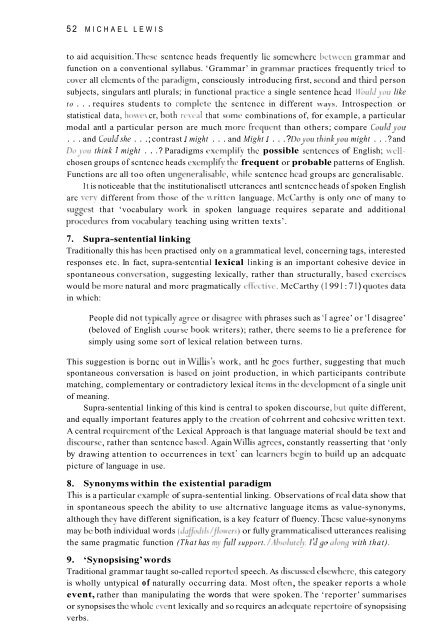Download - Search
Download - Search
Download - Search
Create successful ePaper yourself
Turn your PDF publications into a flip-book with our unique Google optimized e-Paper software.
52 MICHAEL LEWISto aid acquisition. These scntcncc heads frequently lie somc\vhcrc Iwtwccn grammar andfunction on a conventional syllabus. ‘Grammar’ in grammar practices frequently tried tocover all elements of the paradigm, consciously introducing first, second and third personsubjects, singulars antl plurals; in functional practice a single sentence head Cfbuldpi liketo . . . requires students to complete thc scntcncc in different \.rays. Introspection orstatistical data, ho\ve\ cr, 110th re\d that some combinations of, for example, a particularmodal antl a particular person are much morc frequent than others; compare Could~ou. . . and Coiild she . . .; contrast 1 might . . . and Might 1 . . .? Doyon thinkyou might . . .? andDojoti think 1 might . . .? Paradigms cxcmplify the possible sentences of English; \vcllchosengroups of scntcncc heads exemplify the frequent or probable patterns of English.Functions arc all too often ungcneralisablc, \zhilc scntcncc head groups arc gcncralisablc.It is noticeable that the institutionalisctl uttcranccs antl scntcncc heads of spoken Englisharc vclry different from those of the \\ rittcn language. McCarthy is only one of many tosuggcst that ‘vocabulary \vork in spoken language requires separate and additionalprocedures from vocaliulary teaching using written texts’.7. Supra-sentential linkingTraditionally this has liccn practised only on a grammatical level, concerning tags, interestedresponses etc. In fact, supra-sentcntial lexical linking is an important cohesive device inspontaneous conversation, suggesting lexically, rather than structurally, based cxcrciscswould be morc natural and morc pragmatically c4l’cctivc. McCarthy (1 99 1 : 7 1 ) quotcs datain which:People did not typically agree or disagree with phrases such as ‘I agree’ or ‘I disagree’(beloved of English course book writers); rather, there seems to lie a preference forsimply using some sort of lexical relation between turns.This suggestion is borne out in Willis’s work, antl hc goes further, suggesting that muchspontaneous conversation is based on joint production, in which participants contributematching, complementary or contradictory lexical items in the devclopmcnt of a single unitof meaning.Supra-sentential linking of this kind is central to spoken discourse, but quite different,and equally important features apply to the crration of cohrrent and cohcsivc written text.A central requirement of the Lexical Approach is that language material should be text andtliscoursc, rather than scntcncc hascd. Again Willis agrees, constantly reasserting that ‘onlyby drawing attention to occurrences in text’ can learners begin to h ild up an adcquatcpicture of language in use.8. Synonyms within the existential paradigmThis is a particular cxamplc of supra-sentential linking. Observations of real data show thatin spontaneous speech the ability to usc altcrnativc language items as value-synonyms,although they have different signification, is a key fcaturr of fluency. Thcsc value-synonymsmay be both individual words (daffbdils/flower5) or fully grammaticalisctl utterances realisingthe same pragmatic function (That has my full support. /ilbsolut+, I’dgo dong with that).9. ‘Synopsising’ wordsTraditional grammar taught so-called reported speech. As discussed elsewhere, this categoryis wholly untypical of naturally occurring data. Most often, thc speaker reports a wholeevent, rather than manipulating the words that were spoken. The ‘reporter’ summarisesor synopsises the whole nt lexically and so rcquircs an adcquatc repertoire of synopsisingverbs.


